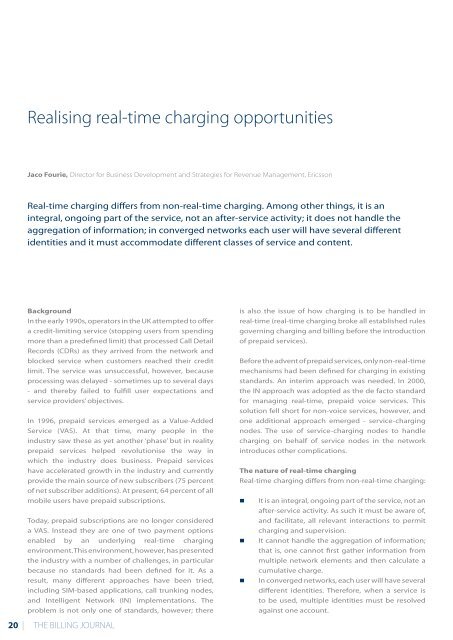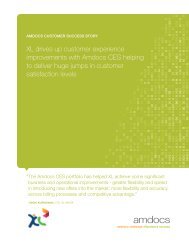The Billing Journal - Amdocs
The Billing Journal - Amdocs
The Billing Journal - Amdocs
You also want an ePaper? Increase the reach of your titles
YUMPU automatically turns print PDFs into web optimized ePapers that Google loves.
Realising real-time charging opportunities<br />
Jaco Fourie, Director for Business Development and Strategies for Revenue Management, Ericsson<br />
Real-time charging differs from non-real-time charging. Among other things, it is an<br />
integral, ongoing part of the service, not an after-service activity; it does not handle the<br />
aggregation of information; in converged networks each user will have several different<br />
identities and it must accommodate different classes of service and content.<br />
Background<br />
In the early 1990s, operators in the UK attempted to offer<br />
a credit-limiting service (stopping users from spending<br />
more than a predefined limit) that processed Call Detail<br />
Records (CDRs) as they arrived from the network and<br />
blocked service when customers reached their credit<br />
limit. <strong>The</strong> service was unsuccessful, however, because<br />
processing was delayed - sometimes up to several days<br />
- and thereby failed to fulfill user expectations and<br />
service providers’ objectives.<br />
In 1996, prepaid services emerged as a Value-Added<br />
Service (VAS). At that time, many people in the<br />
industry saw these as yet another ‘phase’ but in reality<br />
prepaid services helped revolutionise the way in<br />
which the industry does business. Prepaid services<br />
have accelerated growth in the industry and currently<br />
provide the main source of new subscribers (75 percent<br />
of net subscriber additions). At present, 64 percent of all<br />
mobile users have prepaid subscriptions.<br />
Today, prepaid subscriptions are no longer considered<br />
a VAS. Instead they are one of two payment options<br />
enabled by an underlying real-time charging<br />
environment. This environment, however, has presented<br />
the industry with a number of challenges, in particular<br />
because no standards had been defined for it. As a<br />
result, many different approaches have been tried,<br />
including SIM-based applications, call trunking nodes,<br />
and Intelligent Network (IN) implementations. <strong>The</strong><br />
problem is not only one of standards, however; there<br />
is also the issue of how charging is to be handled in<br />
real-time (real-time charging broke all established rules<br />
governing charging and billing before the introduction<br />
of prepaid services).<br />
Before the advent of prepaid services, only non-real-time<br />
mechanisms had been defined for charging in existing<br />
standards. An interim approach was needed. In 2000,<br />
the IN approach was adopted as the de facto standard<br />
for managing real-time, prepaid voice services. This<br />
solution fell short for non-voice services, however, and<br />
one additional approach emerged - service-charging<br />
nodes. <strong>The</strong> use of service-charging nodes to handle<br />
charging on behalf of service nodes in the network<br />
introduces other complications.<br />
<strong>The</strong> nature of real-time charging<br />
Real-time charging differs from non-real-time charging:<br />
• It is an integral, ongoing part of the service, not an<br />
after-service activity. As such it must be aware of,<br />
and facilitate, all relevant interactions to permit<br />
charging and supervision.<br />
• It cannot handle the aggregation of information;<br />
that is, one cannot first gather information from<br />
multiple network elements and then calculate a<br />
cumulative charge.<br />
• In converged networks, each user will have several<br />
different identities. <strong>The</strong>refore, when a service is<br />
to be used, multiple identities must be resolved<br />
against one account.<br />
20 | THE BILLING JOURNAL

















